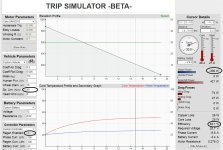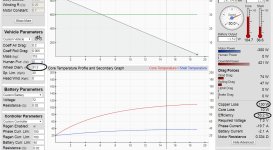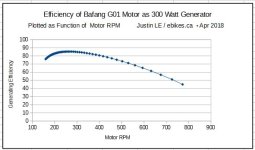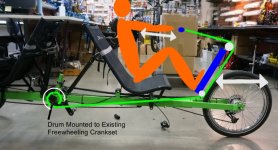tigcross said:
Hey Justin, great to see the progress. Are you going to use a geared hub motor or DD hub motor for your generator? Have you tried out a gearmotor yet for that purpose?
Hey Tig, excellent line of questioning. It's possible to use our
Trip Simulator web app tool to perform a simulation set to see exactly how efficient a hub motor will be as a generator at any given power output and RPM. In my situation, I figure I can average 150 watts reasonably well on a rowing platform, but that is alternating power strokes and recovery strokes of like 300 watts then 0 watts.
In order to use the tool, create a straight line downhill elevation plot, check the "regen enabled" checkbox for the controller parameters, set a vehicle speed limit, and then play around with either the vehicle mass or the %grade until the "Motor Power" field on the right shows exactly the amount of mechanical energy you want to put in the motor. In my case here, I've set that up for -300 watts.
You can see in the "show advanced" column on the right that this hub I've chosen (the SAW20 motor) will produce power with just over 83% efficiency. 300 watts of mechanical power going into the motor, and 248 watts flowing back into the battery.

In this particular simulation, I've set the speed limit to 30kph and used a 16" wheel diameter so it corresponds to the motor spinning at 391 rpm. If I wanted to know the generating effiency with 300 watts going into the hub but it only spinning at 200 rpm, we just change the wheel diameter from 16" to 31.3", and now the 30 kph downhill speed limit corresponds to a 200 rpm hub. Doing that we see that the efficiency drops to a miserable 53%, and I have a full 130 watts of copper loss in the motor. The 391 rpm / 16" wheel test had just 26 watts of copper loss.

And here's where things get more fun and interesting. At the bottom left of the page is a button to launch a simulation set. This lets you have any one parameter cycle through a range of values, with the data output from the trip simulator saved into a .csv file that you can then analyze in a spreadsheet.

In my case, what I want is to find the RPM at which this SAW20 motor will have a maximum regen efficiency with 300 watts of input power. At low RPM's the core losses are low but copper losses are quite high, while at fast RPM's you can have very little copper loss as the phase current for a given power is much lower, but the hysteresis and eddie losses in the core can grow to become substantial.
By varying the wheel diameter from 8" to 40" while the vehicle speed stays fixed at 30 kph, I'm effectively running simulations from 150 rpm up to nearly 800 rpm.
Here's that plot of efficiency vs RPM for that SAW20 motor

We can see that with this motor it would be ideal to gear things so that it will spin at about 475 rpm during the stroke, which will do 83.6% efficiency.
Meanwhile, the exact same test with the larger Crystalyte H3540 motor shows a similar peak of ~84% efficiency, but at just 250 rpm. The SAW20 motor makes most sense since it has the same efficiency yet is smaller and lighter. But if the linkage is such that you can only spin the motor at 200 rpm, you'll be better off with the H series motor.

You asked about small geared motors as generators, and here's that the Bafang G01 looks like:

Not bad at all, better than both direct drive motors so far with a peak over 85% efficiency at 265 rpm
I did this analysis with a range of different motors while exploring which would be the best option to use as a generator for this rowing bike (300 watt power bursts) and here's how they all stack up.

The best for sure is the BionX PL350 motor, over 90% efficient over the very broad range of 350 - 600 rpm. The reason that it fares so well is that the core losses are quite low on this motor compared to comparable size direct drive hubs.
Next up would be the geared eZee motor or the direct drive Grin All Axle hub motor. Both of these can do around 88% regenerating efficiency and both motors weight just under 4kg. However, the eZee motor would have to be spun at a very low 150 rpm, while the Grin motor would need to more like 350 rpm. So the appropriate motor choice in that case would depend if there is an advantage in the gear transmission to having the motor spinning faster or slower.
You can use this same Method TIG to see how any of the motors we have (geared or DD) would fare as a generator in your electrom machine. In that case I would set the power to 150-200 watts rather than 300 watts. The power setpoint of course has a huge effect on the results.










